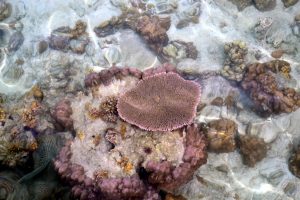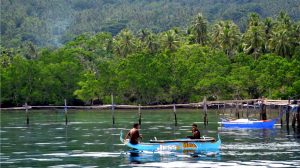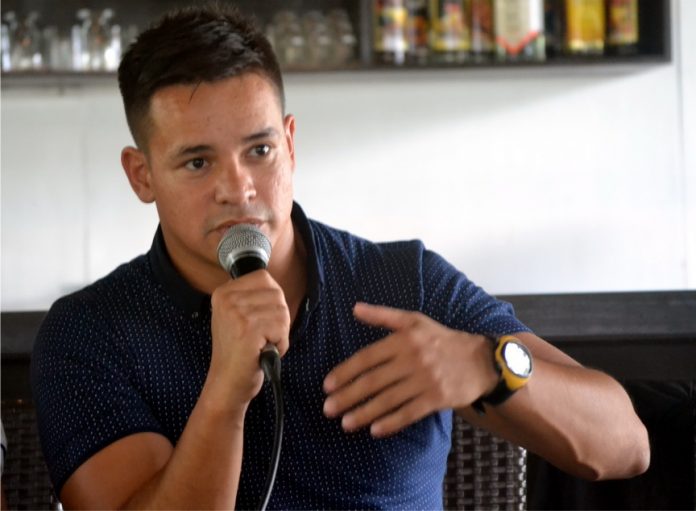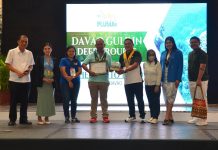Harry D. Morris needs no introduction. A national rugby player, he is known among most Filipinos as a member of the famed Philippine Volcanoes.
But what most Filipinos don’t know about him is that Morris is actually a marine biologist. He graduated in 2006 with honors degree in marine and freshwater biology (yes, he is not only all muscles but also with brain) from University of Essex in England.
“I still have yet to complete my PhD as I focused on my athletic career for over 11 years now,” he admits. “But I will definitely be completing it once my projects are up and running.”
Filipinos can relate with him also as his mother is a Filipina, the former Pilar Dionson. “My mother’s family had a rice milling business and a store. Her father was also a farmer,” Morris reveals in an exclusive interview.
His father is a British national named Toby Morris. “He is a farmer in United Kingdom but was working as a oceanic surveyor when he met my mom, who was then studying,” Morris says.
The union is blessed with five children. Harry is the eldest; he also has a brother who, is also rugby player and a graduate in Sports Science. He has three sisters: the eldest is a nurse who graduated from United Kingdom. The middle one has Masters of Engineering while the youngest is studying classics in Liverpool.
“I’m immensely proud of my family,” he says. “Our mom’s goal was to make us successful in our studies, which most Filipino mothers want of their kids.”
Morris was born in Dumaguete City in Negros Oriental but he grew up in United Kingdom. “I flew back and forth a lot when I was still young,” he says, “but at age 6, I settled in Wales to start school.”
As a marine biologist, he is involved with the Trinity Project of the Hijo Resources Corporation in Tagum City, Davao del Norte. Hijo’s 177-hectare banana plantation, 92-hectare coconut plantation and 60-hectare forest is facing Davao Gulf,“one of the most diverse marine ecosystems in the world,” to quote the words of World Wildlife Fund.
 Davao Gulf may look stunning on the surface but actually it is in deep trouble. “I could see that the coastline (where Hijo’s beach resort is located) was in a state of decline for a long time,” Morris observes. “The sediment had buried everything and was too dynamic to allow seagrasses to take root. The coastline area had retreated by over 100 meters with a loss of 20 hectares or more over the last decade.”
Davao Gulf may look stunning on the surface but actually it is in deep trouble. “I could see that the coastline (where Hijo’s beach resort is located) was in a state of decline for a long time,” Morris observes. “The sediment had buried everything and was too dynamic to allow seagrasses to take root. The coastline area had retreated by over 100 meters with a loss of 20 hectares or more over the last decade.”
The 60-hectare forest, home to hundreds of wild pigs and Philippine monkeys roaming freely around, is also being threatened. “The sea was beginning to intrude into the century-old rainforest, and even though the water showed superb clarity during calm days, any windy period would cause visibility to drop to less than two meters,” Morris reports.
The Trinity Project started in November 2016. In the beginning, it covered only 200 square meters of the area near the corporation’s beach resort. Today, it has expanded to 120 hectares: 20 hectares of mangrove forest, 80 hectares of seagrass meadows and 20 hectares of coral reef habitat.
“After we have completed the 4-kilometer coastline,” he points out, “we will expand the project to neighboring coastline areas.”
But that’s going ahead of the story. How will he accomplish it? “First, we will rehabilitate the damaged coastline,” he says. “Then, we will improve the biological diversity that inhabit this part of the Davao Gulf.”
Morris believes that by rehabilitating the coastline, all three ecosystems – referring to mangrove forest, seagrass meadows and coral reefs – can again do their original functions. The restored coral reef structures will help break and disrupt wave energy below the surface. The seagrass meadow, on the other hand, will buffer the wave energy against the sediment and slow down the movement of the water. Finally, the mangroves will dissipate the wave energy with their prop roots, pneumatophores and trunks before the waves reaches the shore.
Unlike seaweeds, seagrasses are vascular plants – they have a network of veins to move nutrients and dissolved gases around the plant. “The seagrass meadow will not only produce hundreds of thousands of liters of oxygen daily; it will also provide a habitat for spawning fish and their young, crustaceans, mollusks, and sea cucumbers,” Morris says. “Their roots and rhizomes will bind the sand and mud, improve the clarity of the water, as well as encouraging accretion rates of sediments that will benefit any nearby corals aside from building and maintaining beaches.”
On the other hand, mangroves are very important to marine life. “Mangrove forests strengthens the survival rate of fish during their developmental periods, allowing higher numbers of fish to reach sexual maturity and spawn higher numbers. Crustacean populations will boom and attract larger predators to the site, as well as playing an important role in the breakdown of organic material, being occasional detritus feeders.”
Finally, the coral reefs, which the World Conservation Union describes as “essential life-support systems” necessary for human survival, can become habitat for various marine species. “The coral reefs are the optimum environment in the tropical coastal ecosystem, allowing a huge diversity of aquatic life to live and breed in,” Morris says.
“The Trinity Project is actually my design and creation, in partnership with a select few people who possess the same mindset,” Morris says. “I have always wanted to make a real difference in what I do and I strongly believe that this project can flourish and last for generations, long after any of our lifetimes.”
 Morris foresees that the restored coastal ecosystems will continuously get stronger and more and more stable in the coming years. “I believe this can be perfected and replicated all over the Philippines,” he says, adding that it will not only benefit the Philippines but also other areas located within the Coral Triangle.
Morris foresees that the restored coastal ecosystems will continuously get stronger and more and more stable in the coming years. “I believe this can be perfected and replicated all over the Philippines,” he says, adding that it will not only benefit the Philippines but also other areas located within the Coral Triangle.
The Coral Triangle – so named because of its distinct triangular shape, is a region in Asia that includes the Philippines, Malaysia, Indonesia, Timor Leste, Papua New Guinea, and the Solomon Islands.
Not far from Hijo’s Banana Beach, Morris has already placed 20 artificial reefs – known as “bommies” – which were constructed from recyclable scrap metal and porous stones. “At the end of March this year, we will allow our guests to have a snorkeling experience underwater using a long-hose scuba system,” Morris says. “There is no certification needed and the guests can walk on the seabed amongst the reef structures at a depth of less than 5 meters. They can interact with the fish and sea-life there whilst experiencing first-hand how the Trinity project is developing.”
Davao Gulf needs to be restored to its former self. After all, it is Southern Mindanao’s fishing ground. “Davao Gulf is a critical resource supporting the economies of six coastal cities and 18 coastal municipalities,” says the Davao Gulf Management Council, composed of all local government units surrounding the gulf.
With the initiatives introduced by Morris, there is a possibility of saving the Davao Gulf from annihilation!







